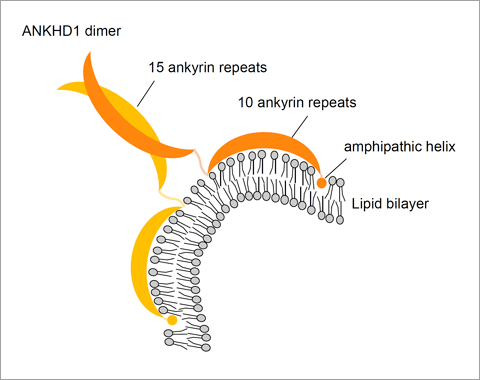Research outcomes
Protein scissors for cellular transport
In many ways, a cell is like a city. Proteins or people do daily work to keep the economy going, and items are imported and exported for trade. Imports are shipped into cells by way of endocytosis. Before reaching their final destination, they are kept at the early endosome, a structure that determines whether the material will be disposed, recycled or delivered to a specific region in the cell. A new study in iScience by researchers at the Nara Institute of Science and Technology (NAIST), Japan, demonstrates how ankyrin repeat and KH domain-containing protein 1 (ANKHD1) are instrumental in forming the early endosome.
Endocytosis describes the formation of vesicles at the membrane and then transports inside the cell.
"The cell moves material through vesicles that are cut from the membrane. Only a small number of proteins are known to execute membrane scission, and these proteins include BAR domain proteins," notes NAIST Professor Shiro Suetsugu, who managed the study.
"ANKHD1 contains an ankyrin repeat domain [ARD], which we previously found to have lipid-binding ability," he continues. Ankyrins are proteins that bind to proteins, but their membrane binding capacity is relatively unexplored.
To investigate more about ARD, the study began with 600 candidates, but settled with ANKHD1 when liposome sedimentation assays indicated its ARD had strong vesiculation activity.
The ARD of ANKHD1 contains 25 ankyrin repeats that the scientists divided into one group of 15 and another group of 10. To test the function of these two groups, they established a series of ANKHD1 constructs: one ARD with all 25 ankyrin repeats, one with only the group of 15 and one with only the group of 10, with the first two including the N-terminal, and tested how these constructs reacted with liposomes.
"We found that the two groups had different roles, vesiculation and dimerization," says Suetsugu.
The vesiculation ability of the group of 10 broke liposomes down into small vesicles and was attributed to an amphipathic helix and electrostatic interactions with the liposome, but this ability was enhanced by the dimerization of the group of 15. This process resembled how BAR proteins interact with membranes.
Moreover, reducing the ANKHD1 expression in mammalian cells increased the size of the early endosome, indicating a membrane-deformation function that could impact intracellular trafficking.
"The vesiculation of early endosomes is a crucial and early step in intracellular trafficking, but very little is known about the proteins that regulate this system. Abnormalities at this stage can have a tremendous impact on many cellular functions," says Suetsugu.

Resource
- Title: Membrane-deformation ability of ANKHD1 is involved in the early endosome enlargement
- Authors: Manabu Kitamata, Kyoko Hanawa-Suetsugu, Kohei Maruyama & Shiro Suetsugu
- Journal: iScience
- DOI: 10.1016/j.isci.2019.06.020
- Information about Prof. Suetsugu lab can be found at the following website: https://bsw3.naist.jp/suetsugu/?cate=278
[Press Release] June 02, 2019
( July 02, 2019 )
